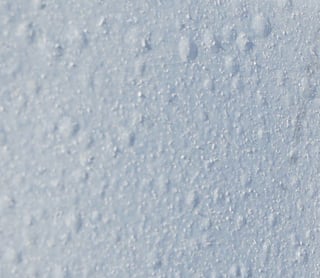
What Causes Osmotic Blisters on Fiberglass Pools?
Fiberglass Pool Information | Installation & Construction
Ok, if you’re following our series on fiberglass pool manufacturing, you’ve already learned about the defects that can result from improper mold maintenance as well as the importance of proper gel coat application in manufacturing.
Today we’re going to discuss the third phase in the fiberglass pool manufacturing process, the vinyl ester resin layer, and the importance it plays in building a long lasting pool.
The Vinyl Ester Resin Layer
What is the vinyl ester resin layer?
Try to stay with me on this analogy…ok?
Let’s pretend that the water in your pool is like your teenage daughter. Let’s also pretend there’s a really cute guy in the neighborhood that she wants to date, but you know the dude is bad news. His name is polyester resin. If your daughter hooks up with him, bad stuffs gonna happen. So like any good parent, you do what you can to prevent her from dating that dirt bag. Instead, you introduce her to that sweet boy at church.....vinyl ester resin.
The vinyl ester resin layer of your fiberglass pool prevents the water from coming in contact with the lower quality polyester resin.
What Happens When the Water Comes in Contact with Polyester resin?
Water molecules are so tiny that they actually pass through the gel coat (surface) layer of the pool. If they are allowed to come in contact with the cheaper polyester resin that is used in the outside layer of the pool, the molecule will combine with other particles in the resin and form a larger combined molecule.
If the combined molecule stayed put, all would be well. But you know teenage girls….always on the move! So when the combined molecule tries to pass back through the gel coat layer, it’s too large to fit. This results in damage to the gel coat in the form of osmotic blisters.
What do Osmotic Blisters Look Like?
They are normally the size of a dime or smaller and look just like you would expect a blister to look…like slight bubbles that are raised on the surface of the pool. They do not go away and unfortunately, there’s no quick fix either.

How Common Are Osmotic Blisters?
Osmotic Blisters are all but extinct in new pools today. Before vinyl ester resin became an industry standard decades ago however, they were not uncommon.
How Thick Should the Vinyl Ester Resin Layer of a Fiberglass Pool Be?
A typical vinyl ester resin layer has a thickness of approximately 100 to 120 mils thick.
- Too thin and water passes through and blisters occur
- Too thick and the pool becomes too rigid
So, there you have it!...the importance of an adequate vinyl ester resin layer in fiberglass pool manufacturing.
If you live in Virginia or Maryland, we'd love to provide more information about inground pools.
Please feel free to chime in and leave a question or comment below.
Thanks!
At River Pools, we manufacture world-class fiberglass pools for customers across North America. If you'd like to get a fiberglass pool, you can check out our catalog of models, try our pool pricing calculator, or download our free ebook below!
Fiberglass Swimming Pools 101: Manufacturing, Cost, and More
Shopping for a Fiberglass Pool Shell? 6 Things to Look for
A Guide to Inground Swimming Pool Size, Costs, and Prices: Everything You Should Know
Editor's note (5/16/24):
This article was originally written by Jason Hughes, (Founder, River Pools Virginia, Genesis Course Instructor). Any opinions expressed are those of the author. Any prices referenced were based on information that was readily available at the time.
River Pools is a brand of inground fiberglass pools produced via the River Pools division of the manufacturing facility in Fortville, IN. While our expertise is in fiberglass pool manufacturing, we have a network of expertise relating to all things inground pools. Our own collective experience from over the years spans manufacturing, project design, installation, and pool service. We often tap into this knowledge base and share information freely with homeowners, just like you, who are considering having a swimming pool installed in your backyard.





